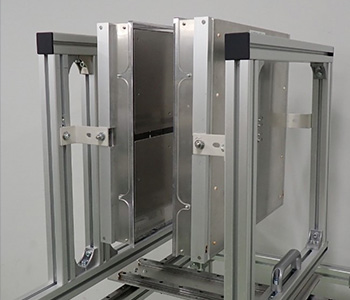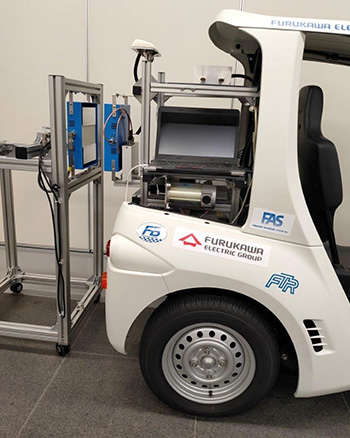World's First Successful Use of Electric Resonance Coupling to Wirelessly Transmit 4.7 kW of Power
- Aiming for Early Commercialization of a Wireless Power Source for Mobile Devices -
- Supplies power to electric personal mobility vehicles, robots, and other mobile devices without the need for connecting cables.
- Contributes to the environment by enabling smaller, lighter products and by increasing power output and efficiency.
- Enabled power transmission of 4.7 kW over a distance of 95 mm for the first time in the world using an electric resonance coupling system.
Furukawa Electric Co., Ltd. (Head Office: 2-2-3, Marunouchi, Chiyoda-ku, Tokyo, President: Keiichi Kobayashi) is now the first company in the world to successfully transmit 4.7 kW of power at 13.56 MHz wirelessly over a distance of 95 mm. This achievement was made using the electric resonance coupling system being developed by the Automotive Products & Electronics Laboratories. By taking advantage of their lightweight nature and the fact that electric resonance couplers do not heat foreign metals, we are aiming to apply wireless power supply to the next generation of electric personal mobility vehicles, robots, and unmanned vehicles.
Background
Among the different methods of wireless power transmission(note 1), we have been researching and developing electric resonance coupling(note 2) systems. These systems can be combined with 13.56 MHz(note 3), 27.12 MHz, and other HF bands to miniaturize the resonance coils as a means of engineering lightweight power transmission/receiving couplers. In principle, however, this approach has been considered unsuited for high power transmission, so there were no previous examples of transmitting power exceeding 2.5 kW at 13.56 MHz. As part of our research, however, we succeeded in transmitting high power at high efficiency by reexamining the structure of the coupler.

Details
- Transmission power: 4.7 kW (Continuous)
- Coupler(note 4) efficiency(note 5): 94% (forced air cooling)
- Transmission distance: 95 mm
- Coupler unit (excluding cooling fans), size: H 480 mm x W 480 mm x D 100 mm, weight: approx. 4.3 kg
- Power supply: 13.56 MHz, water-cooled, class AB, 5 kW RF power supply (commercial power supply)
- Along with working to miniaturize and improve the efficiency and power output of the coupler, we are also developing a high-frequency power source using a GaN device with the aim of commercialization around 2025.

Environmental harmony initiatives
Our goal is to help prevent global warming by improving the convenience of next-generation personal mobility vehicles through the realization of high-efficiency, wireless power transmission.
Glossary
(note 1)Wireless power transmission: A technology that transmits power through space without the need for wires or cables.
(note 2)Electric resonance coupling: A type of wireless power transmission technology that transmits power using the resonance phenomena enabled by LC resonators (couplers) composed of a coil and an electrode.
(note 3)13.56 MHz: An internationally regulated ISM frequency. Transmitting power in this frequency band requires a power semi-conductor capable of high-speed switching; therefore, the use of GaN (gallium nitride) is being widely investigated.
(note 4)Coupler: A power transmission/receiving unit composed of a resonant electrode, a small resonant coil, and a shielding case.
(note 5)Efficiency: The conversion efficiency between commercial power supplies (input) and power consuming devices (output) is important; therefore, the coupler unit located in between must maintain a high efficiency.
(note 6)Magnetic resonance coupling: A method for transmitting power using couplers composed of coiled Litz wires. Although this method is ahead in terms of standards, etc., drawbacks include its heavy weight due to being made of ferrite and the fact that foreign metals between the couplers are heated.







 Share
Share Tweet
Tweet Share
Share